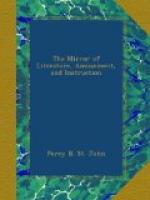[5] See the Rhinoceros Bird, page 312. The Mirror, No. 547.
The CLAW is that of the PILEATED WOODPECKER, (Picus Dryotomus) Pileatus, SWAINSON, which has much less power than the claw of the typical Woodpecker; the anterior toe (i.e. middle toe,) being longer and stronger than the posterior—a structure the very reverse of that which characterizes the typical species.
LEGS AND FEET of the ROCKY MOUNTAIN SPOTTED GROUSE, (Tetrao Franklinii, DOUGLAS,) which are thickly covered with long and hair-like feathers. The bird inhabits the valleys of the Rocky Mountains from the sources of the Missouri to those of the Mackenzie, and Mr. Douglas informed Dr. Richardson that it is sparingly seen on the elevated platforms which skirt the snowy peaks of Mount Hood, Mount St. Helens, and Mount Baker. He adds, “It runs over the shattered rocks, and among the brushwood with amazing speed, and only uses its wings as a last effort to escape.”
The birds of North America include about 320 species. They are divided into migratory and resident; though comparatively few in the fur countries are strictly entitled to be called resident. The raven and Canadian and short-billed jays were the only species recognised as being equally numerous at their breeding-places in winter and summer. Many of the species which raise two or more broods within the United States rear only one in the fur countries, the shortness of the summer not admitting of their doing more. We have mentioned the number and beauty of the hawks and owls. The white-headed eagle inhabits the fur countries as well as the United States. The melody of the song-birds is described to be exquisite. The verdant lawns and cultivated glades of Europe fail in producing that exhilaration and joyous buoyancy of mind which travellers have experienced in treading the Arctic wilds of America, when their snowy covering had just been replaced by an infant but vigorous vegetation. The duck family are, however, the birds of the greatest importance, as they furnish, in certain seasons of the year, in many extensive districts, almost the only article of food that can be procured. The arrival of the water-fowl, it is said, marks the commencement of spring and diffuses as much joy among the wandering hunters of the Arctic regions, as the harvest or vintage in more genial climates. The period of their emigration southwards again, in large flocks, at the close of summer, is another season of plenty bountifully granted to the natives, and enabling them to encounter the rigour and privations of a northern winter.
Dr. Richardson acknowledges the liberal assistance afforded him by the Hudson’s Bay Company, in the collection of specimens. Indeed, to this public-spirited body are we indebted for our earliest systematic knowledge of the Hudson’s Bay birds. The reader may likewise witness a few living evidences of the Company’s liberality, in the fine collection of eagles and owls presented by them to the Zoological Society, and exhibiting in the Gardens in the Regent’s Park. Such devotion to the advancement of science cannot be too proudly perpetuated in the history of a society established for commercial objects.




